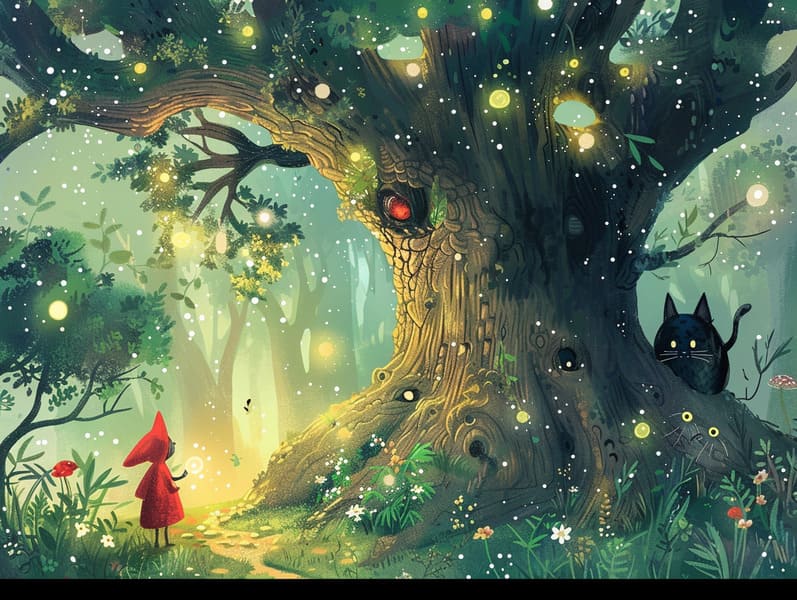
Famous fairy tales have old origins. These tales have been relayed from one generation to the next centuries before they were ever recorded. They sprang from a variety of societies, including Western traditions. They were initially passed along among grown-ups, often carrying themes and messages reflective of the societal norms and beliefs of the time.
Jacob and Wilhelm Grimm, Jacob and Wilhelm, were among the first to gather many of these beloved tales. Their compilation, "Grimm's Folk Tales," included narratives like "Cinderella," "The Story of Hansel and Gretel," and "Snow White," which have since become pillars in the world of classic fairy tales. Similarly, the Danish author's magical tales, such as "The Story of the Little Mermaid," and "The Ugly Duckling," have enchanted hearts worldwide, securing their place in the pantheon of classic fairy tales.
Though they are centuries old, these stories remain as significant as ever, especially as children's night stories. These fantastical tales are now available in various formats, including beautifully illustrated books, whimsical animations, and digital storybooks.
Their ongoing significance can be connected to several charming aspects:
Life Lessons: Old fairy tales often share important moral lessons. Stories like "The Story of the Boy Who Cried Wolf" teach the significance of honesty, while "The Race of the Tortoise and the Hare" emphasize the traits of tenacity and modesty. These tales offer children clear distinctions between correct and incorrect, forming their moral compass in a gentle yet lasting way.
Compassion and Knowledge: Ancient fairy tales frequently depict individuals facing obstacles and hardships, prompting children to resonate with their struggles and rally behind their triumphs. For instance, "Beauty and the Beast" highlights the virtue of looking deeper to realize the real character of a soul, cultivating insight and perception.
Cultural Understanding: Many fairy tales are imbued with the cultural contexts from which they arose. Delving into these fairy tales can provide captivating looks into different societies, advancing a sense of cultural respect and respect.
Imagination and Creativity: The whimsical elements in classic fairy tales—magical kingdoms—foster children’s creative minds. These tales bring readers to magical realms, fostering creative thinking and a sense of delight that stays a lifetime.
Ancient fairy tales are not only spellbinding but also informative. They function as spellbinding tools in advancing various cognitive and affective skills in children. When old fairy tales are spoken, they promote speaking abilities by showing new phrases and intricate sentence structures. This practice also nurtures hearing perception and attentiveness, as young readers keep up with the story, ready to see what happens next.
Furthermore, conversing about the themes and characters of classic fairy tales can improve analytical skills and thinking skills. Kids are instructed to notice patterns, forecast, and make sense of cause and here effect. These explorations also advance children say their thoughts and feelings, boosting their emotional intelligence.
In today’s digital age, the availability of web-based fairy tales has made these fairy tales more obtainable than ever. Online resources and online apps supply large libraries of classic fairy tales that can be accessed or listened to anytime, anywhere. Fairy tales read out loud are particularly sought after, offering an fascinating method for kids to take part in these entrancing tales. Audiobooks and spoken videos guide characters and settings to life, often supported by entrancing harmonies and tunes that enhance the story adventure.
The persistent attraction of timeless fairy tales lies in their ability to shift to changing times while keeping hold of their main lessons. Contemporary updates of these fairy tales often feature more representative figures and modern settings, making them relevant to today’s audience. However, the essential messages of valor, benevolence, and truth remain unchanged, continuing to reach children of all ages.
Old fairy tales also offer a sense of peace and familiarity. They confer upon a ordered narrative with a definite beginning, middle, and end, often finishing with the resolution of conflicts and the triumph of virtue over vice. This consistency can be encouraging for children, granting a sense of unwaveringness in an always shifting world.
Classic fairy tales continue to captivate and guide new generations, maintaining their grandeur and meaningfulness in modern society. As children's bedtime stories, they distribute a perfect blend of fascination and comprehension, boosting moral values, empathy, and creativity. The presence of digital storybooks and the favor of fairy tales recited warrant that these ancient fairy tales remain available to new generations.
By holding onto and conveying these narratives, we continue to honor the rich tapestry of tales and cultural heritage. Whether you are viewing a vividly illustrated book, accessing a digital library, or listening via an voice book, the charm of traditional fairy tales is always within reach. These fairy tales highlight of the consistent spell of stories and its ability to bring us together across eras and regions.
Whether you are seeing a gorgeously illustrated book, seeing a web-based collection, or playing an audio story, the captivation of timeless fairy tales is always within reach.
These fairy tales highlight of the unwavering ability of storytelling and its ability to tie us across epochs and places, establishing a link that fascinates and enlightens alike.